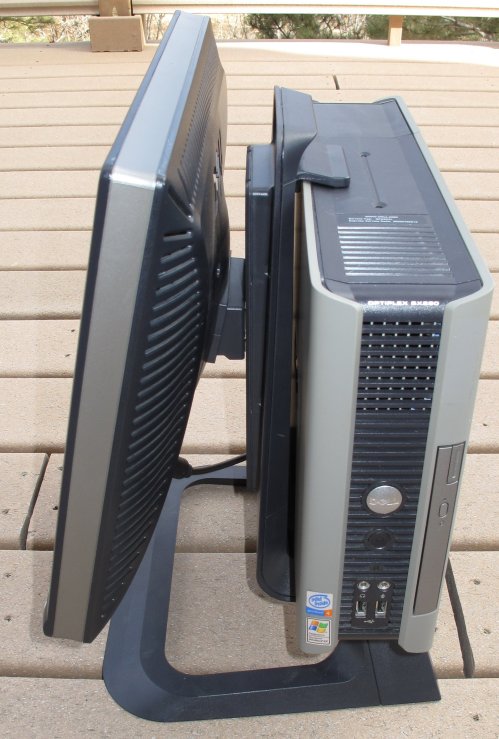
I’ve changed my mind again; take note, and remember that it’s good practice. I recommended the Dell SX270 here over the SX280 last fall. Having had some time to spend with a couple of SX280s, I’m thinking that the SX270’s day may be past.
I’ve been configuring and using Dell’s SX270 Ultra Small Form Factor (USFF) machines for several years now, and mostly I love them. They’re rugged, tiny, quiet, reliable, and come with a BIOS-locked version of XP Professional that does not need activation. (The disc can’t be installed on anything but a Dell SX270, and because every last SX270 out the door had a paid-for Windows instance on it, Microsoft figures they won’t lose anything by giving over WPA, and they’re right.) The SX270s were made and sold between 2003 and 2005, and given that they were almost entirely corporate fleet machines, five years later they’ve mostly been written off by their corporate owners and dumped on the resale market. That’s why they’re so cheap; a quick check of completed auctions on eBay right now shows dozens of units selling for between $60 and $100, and a few full systems (including flat panel monitor, keyboard, mouse, and the combo system unit/monitor stand) for between $100 and $150.
There are a nonetheless few downsides to the SX270:
- They’re limited to 2 GB RAM. This can be an issue, depending on what you’re doing with them.
- They use 2.5″ laptop IDE hard drives, which are more expensive (and less capacious) than the conventional 3.5″ drives most larger PCs contain.
- Their integrated graphics systems are not meant for animated video games, and the slower machines (slower than 3 GHz) do not render video very well.
In 2005, Dell replaced the SX270 with the SX280 USFF, which is about 15% larger but still mighty small. The SX280 is a better machine in a number of ways:
- It can take up to 4 GB RAM, though you have to be careful what you put in it. (More on this in a moment.)
- It uses ordinary 3.5″ SATA drives, which means you can pack 1.5 TB into the little box for about $120.
- The integrated graphics chipset is faster and more versatile–if still not quite versatile enough.
- It opens up and field-strips a lot more easily than the SX270.
Until very recently, SX280s were fairly scarce and went for $250-$350 used. But a few months ago I noticed that SX280 prices were imploding, and they’re now as cheap (and in many cases cheaper) than the SX270, sometimes as cheap as $50. In fact, a week or so ago, a full 2.8 GHz system like the one shown above (which I will be installing in our parish office shortly) sold for $103, including the Dell HC317 17″ monitor on stand, mouse, and keyboard.
The SX280 is a little fussy about the sort of DDR2 DIMMs you put in it. Crucial has a nice lookup service for Dell (and many other) computers, and I ordered 2 2GB DIMMs from them. Go here and look for the Crucial Memory Advisor. If you buy the ones specified for your model, they’re guaranteed to work, and mine did.
Seeing SX280s cheaper than 270s is a little odd. It may be that the supply of workable SX270s is drying up; after all, they went out of production five years ago. Doesn’t matter; the SX280 is a better machine, and if you mount it on an HC317 stand behind the 17″ monitor, it’s no larger than the similar 17″ piggyback system incorporating an SX270. The HC317 stand is VESA compatible, so if you have a larger VESA monitor it’ll bolt right on.
The big downside, as I’ve alluded to before, is that neither the SX270 nor SX280 will display a native 16 X 9 raster under Windows. I’ve tried to coerce the Intel chipset to do 16 X 9 to no avail–which is infuriating, since Ubuntu detects my widescreen monitor and somehow drives the Intel GMA 900 controller at 1600 X 900 automatically, with no input from me.
Anyway. If you’re looking for a small and quiet officework machine for cheap, the SX280 just got cheap. Highly recommended.











I *so* want to believe in these… but my experience has been sub-optimal… 2 SX280s that I bought from eBay this fall were bad out of the box. 1 SX270 was solid. Waste of many hours, unfortunately. More details at: http://www.techfornonprofits.com/blogger/labels/Hardware.html
That’s interesting. Did you get them all from the same vendor? I’ve now purchased 11 SX270s and 1 SX280, all from (various) eBay vendors, and not only was every one good out of the box, only one has given me any grief. (Not being able to do widescreen video modes doesn’t count.) The one failure was a dying coin cell, and after replacing it everything went back to normal.
I’m still “in touch” with all of them: Four are in service here at my house, one at my condo in Chicago, three at our church, and three more are used by relatives and friends. None have acted up. I’m sure they won’t last forever, but again, I consider them disposable machines.
I actually read your article some weeks ago, and thought, “Boy, this guy has lousy luck.” I wonder whose luck is more typical, yours or mine?
Crazy business.
Older Optiplex models (mostly produced in 2003 and 2004), notably the GX270, suffered from frequent failures due to faulty capacitors supplied by Nichicon. These capacitors would bulge and leak, resulting in product failure after only a few years of use. As of June 2010, there is still ongoing litigation regarding this problem, alleging that Dell knew that the computers were likely to fail, and continued to ship them.[1]